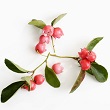
A recent review raised concerns that some patients might be consuming higher amounts of salicylates than they realize, putting them at risk for chronic salicylate toxicity. This is a particular concern in the elderly population, in which polypharmacy is common and some of the symptoms of chronic salicylate toxicity may be misdiagnosed. Examples of these symptoms include tachypnea, acid-base imbalance, altered mental status, and neurologic abnormalities. There are many hidden sources of salicylates, including foods, herbs, supplements and topical products. But it’s not always easy to identify the ingredients that should be avoided or used in moderation in patients already taking salicylate-containing medications.
Wintergreen oil contains 96-98% methyl salicylate. Taking wintergreen oil by mouth or applying it to the skin, particularly while also applying heat, can significantly increase absorption and lead to toxicity. Wintergreen oil is found in some vapor rub products – patients should be advised to avoid this ingredient if taking prescription drugs or OTCs that also contain salicylates.
Turmeric and cumin are both spices commonly promoted for their “healing” and anti-inflammatory effects. Turmeric is regularly reported as one of the most widely used herbs in the US. While both of these herbs are likely safe when used appropriately, both spices contain salicylates. Tell patients to use them in moderation, particularly cumin, if they are taking other agents containing salicylates.
Some research shows that black pepper has a surprisingly high concentration of salicylates. While consuming very high amounts of black pepper might be difficult, people already using several products containing salicylates might try switching to white pepper instead. The salicylate content of white pepper is much lower.
In addition to concerns about salicylate toxicity, there is some growing interest in a “low salicylate diet” for people who are hypersensitive to salicylates, as well as those with certain conditions, including nasal polyps and asthma. To learn more about which foods, herbs and supplements contain salicylates, check out our new charts on Salicylate-Containing Foods and Salicylate-Containing Herbs & Supplements.
The information in this brief report is intended for informational purposes only, and is meant to help users better understand health concerns. This information should not be interpreted as specific medical advice. Users should consult with a qualified healthcare provider for specific questions regarding therapies, diagnosis and/or health conditions, prior to making therapeutic decisions. Copyright © 2024 NatMed. Commercial distribution or reproduction prohibited. NatMed is the leading provider of high-quality, evidence-based, clinically-relevant information on natural medicine, dietary supplements, herbs, vitamins, minerals, functional foods, diets, complementary practices, CAM modalities, exercises and medical conditions. Monograph sections include interactions with herbs, drugs, foods and labs, contraindications, depletions, dosing, toxicology, adverse effects, pregnancy and lactation data, synonyms, safety and effectiveness.
